According to Wired, SCO is suing everyone. For those not keeping score, here is a short timeline of things in SCO-land…
More »
WELL I had another conversation with someone about Microsoft V Linux
I would love to know why I get into some many conversations about it, it much be because I am willing to stand up for companies that many people put down Namely Microsoft.
I wish people would just realize that companies are not out there to give you everything you want on a silver plater.
Um, let’s see how many English errors we can count, and then subtract that from the level of seriousness with which to take the opinions expressed therein.
Again I say – If you want someone to take your opinions seriously, spellcheck, proofread and then re-think the entire posting. After you’ve thought about it and run it through “ispell” or some other such tool, then go ahead and post. Your views might still be stupid, but more people will listen to them anyway.
current_music: The Vandals – Christmas Time for my Penis
Friday –
There have been a series of articles on ZDNet (and therefore on Yahoo Tech) about Linux and Open Source vs. Windows and Shared Source.
I am still amazed, after so long using Linux and Windows (as well as Solaris and Xenix) that the two sides are so entrenched that they can’t even have a rational discussion.
The Linux fanatics (not users, just the fanatical ones) automatically associate anyone who doesn’t call Windows Windoze or Windoofs with the evil empire. Apparently it’s some sort of requirement to put dollar signs in all things MS-related in order to show one’s disdain for the company and their (obviously) inferior products.
Meanwhile, the Windows fanatics (same disclaimer) portray all Linux users as programming geeks, with some strange communist or socialist bent. They further seem to believe that Linux users are like children, and should be shown the error of their ways, since they obviously don’t understand how business works.
I think it’s all quite apparent. The two sides have nothing in common. I don’t mean that completely literally, since they obviously both are looking at the prevalence of their favorite operating system in the market (or community, depending on your bent). When I say they have nothing in common, I mean that they are approaching computing from two completely different philosophies, and neither set of fanatics is capable of seeing that there may be others who don’t find their views completely transparent as soon as they’ve been explained forcefully enough (preferably with cursing or semi-random spelling errors). Â
Linux is a good OS, and it keeps getting better. It is stable, although not as stable as BSD. It is fast, and it has decent support for hardware and various filetypes. Its adherents are generally propellorheads, but not exclusively. They know it is a solid system, and it can do great server things and decent desktop things. They also are unconcerned with market share, because it fits their needs now, and they don’t care if grandma uses it or not. Basically, there is no desire to dominate the marketplace. To Linux adherents, there is no marketplace
Windows is a decent OS, with an amazing amount of cruft built up over the years of backward-compatibility. Linux does not need to be backward compatible, since it has no “market” to worry about, and there is no company running the show. Windows is slow and unstable, but supports every file format around, and is easy to use. The Windows zealots are sure that Linux is run by some secret communist cabal, and the sole purpose of any software is to own the market. The fact that Linux is not trying overtly to conquer the desktop market just means they don’t have the strength to do so yet.
Where it gets entertaining is when people talk about the “ease of installation” problems with Linux vs. Windows. HA! Linux takes me 30-45 minutes to install, and Windows 2 hours or more. The reason people can continue to get away with claiming Linux is a bear to install is because almost nobody outside of powerusing geeks ever installs Windows. It came on your machine, and it stays there.
But, you must install Linux on most machines, and so you can see how annoying installing an OS can be.
Other fun things to think about are when folks claim that there is no problem with GNU/Linux as an OS, the problems are all in poor support from hardware and software vendors. Sorry to tell you zealots, but that’s irrelevant to Joe User. If he can’t watch 405 the Movie on his system, he doesn’t care that the real blame lies in the patents behind the Sorenson codec. To him, Linux sucks.
That’s about all I can come up with today. Hope you enjoyed this short primer on Linux-vs-Windows.
Last Edit: 23 Feb 2006 @ 02:38 PM
Email • Permalink • Comments Off on Linux Controversies

There’s yet another story about Linux PDAs, this one from the venerable Hewlett-Packard, possibly moving the Jornada line to Linux or Palm since WinCE blows.
There are plenty of other examples of such promises or hints, including some actual physical devices, yet nobody has brought one to market yet. What the hell? Here are the examples, can someone tell me why they aren’t done yet? Yopy has been hyped on Slashdot and elsewhere since February 2000, supposedly to ship in the summer of 2000. Still nothing. Agenda‘s VR3 has been discussed since August, but still not shipping except to developers.
Of course, Gateway is shipping their AOL webpad thing running Linux, but c’mon, it’s America OnLine! Besides the fact that it isn’t portable, it’s not much use except to check AOL email. And, really, if you are buying an internet appliance for your home, you probably don’t use AOL. AOLers don’t know what “internet appliance” means, for crying out loud.
current_music: Prodigy – MindFields
current_mood: bored
Sunday –
Just showing off how much stuff I can have running on my machine without a slowdown. A friend was comparing his Windows experience with my Linux one. He has to reboot about every 8 hours or so. As I took this screenshot (and the 800×600 mini one), I had gone over 5 days since rebooting. And, the only reason I had reset then was because I had to do some audio editing in Windows, not because Linux crashed. Damn, I’m smoove.
I promised a big site re-write in June, but I ended up postponing my leave until July, and then leaving town instead of playing with my website. Sorry, but such is the pull of a new girlfriend in another state. 🙂
So, I may get to a reorganization in September, but maybe not. Deal.
I’m down to 8 months until I finish my indenture to the Army. I suppose that’s too early to be looking for a job, but I can’t wait!
Last Edit: 04 Jun 2004 @ 05:05 PM
Email • Permalink • Comments Off on Well That Was Odd

Monday –
 Well, here’s another screenshot of my Linux machine (and the 800×600 shot). Not much has changed in a while, which is a pretty good indication that I like it the way it is. I took this capture for two reasons: Alicia Witt is hot, and LICQ has a new version, which supports the floating window seen above Alicia’s head. Oh, and the skins for GKrellM now can skin the GKRellMMS buttons, as this cool Aliens skin shows.
Well, here’s another screenshot of my Linux machine (and the 800×600 shot). Not much has changed in a while, which is a pretty good indication that I like it the way it is. I took this capture for two reasons: Alicia Witt is hot, and LICQ has a new version, which supports the floating window seen above Alicia’s head. Oh, and the skins for GKrellM now can skin the GKRellMMS buttons, as this cool Aliens skin shows.
I’ve been working some very very strange hours lately, so if you see me online, I may have just left the ICQ or AIM window open and gone to work or sleep. I’m not responsible for my actions of late. 🙂
Still looking for a purpose after the Army lets me escape next year. Anyone with a cool job in Central California (or San Diego I guess), for someone with my obvious talents in graphics, audio, web design, and just all-around geekiness?
Stay tuned for a big site re-write in the next month. I’ve got a few ideas for cleaning things up and making the site easier to navigate. Maybe I’ll even formally set up Linux and SIGINT sections.
Last Edit: 05 Feb 2007 @ 05:47 PM
Email • Permalink • Comments Off on I Wanna Good Job

Wednesday –
I’m using Linux pretty much exclusively these days, but sometimes there is a glaring lack in the Open-source world.
I enjoy burning CDs to listen to in my car, rather than making cassettes as I did 15 years ago. No biggee, right?
I can burn audio CDs very easily in Windows, and kind of easily in Linux. Here’s where it gets weird. I took a series of tracks that came from old cassettes or CDs or even (heaven forbid) MP3 files, and wanted to make a themed audio disc for the drive to work. I wanted all the songs to be nearly equivalent in volume, and some of them had been recorded at much reduced volume levels than others. So, I ran them through the "equalize volume" feature of Spin Doctor (a feature of Easy CD Creator in Windows). Then, since I was in Windows, I had Easy CD Creator make the disc. I surfed the Net while waiting for my burner to finish, and then played the CD on the way to work (great lunch break, eh?). It sounded like crap in places.
I had forgotten one of the primary rules of Windows: it sucks at multitasking. After making several data CDs in Linux, I’d forgotten that Windows doesn’t want you to do ANYTHING else while you’re burning a CD. So, although there were no errors reported by the CD-R program, and no apparent buffer under-runs, the CD was a coaster.
Fast forward to the next evening. I rebuild the tracks, all in Linux. I used MPG123 to convert the MP3s to WAV files; I used CDParanoia to rip the CD tracks to WAVs, and I eventually used cdrecord (at the command line even!) to burn the tracks to CD. The glaring omission in all this is the audio editing. I can’t find a decent audio editor for Linux. I’ve looked, and found a lot of half-finished projects that may turn out to be worthwhile someday. But, nothing to compare to CoolEdit or SoundForge is available for my favorite OS yet. So, I put together my pack of WAV files, booted into Windows, equalized the volume with CoolEdit (sweet program) as well as chopping out some dead air. Then, I rebooted into Linux to make the CD.
Seems like a waste of two boots, eh? I wish I had a Gigahertz machine so VMWare didn’t seem so damned slow…
I’m outta here. Surf well.
Last Edit: 05 Jun 2004 @ 07:54 AM
Email • Permalink • Comments Off on Good Windows Programs

Sunday –
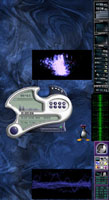
Playing with cool toys some more this weekend. I’ve got some visualization plugins for XMMS that are pretty weird. Here’s a screenshot of one hiding between Gkrellm and the WM Dock. I’ve got a bunch of Plugins running here: Waterfall, Synaesthasia, BlurScope, GDancer (with the Penguin addon), and KJofol. Naturally, I’ve got a lower-res version for you poor souls with small monitors. 🙂
The quest to pipe a playlist to the CD-R was solved by a Linux hacker on one of my mailing lists. All is right with the world. Here’s the secret: The "for" loop in the BASH shell doesn’t care about the standard quote method of using long filenames. Since BASH chokes on long filenames, it wouldn’t handle the standard method of sending MP3s to the CD-R. But, a geek sent in the following redefinition of the IFS variable that does the trick.
IFS=$(echo -en nt)
Once you type in that line, you can pipe the FOR loop to the recorder and it works fine. Assuming you’re using a terminal from within X, just close the term window and you’ll reset the IFS variable back to normal. Magic, eh?
Last Edit: 04 Jun 2004 @ 05:06 PM
Email • Permalink • Comments Off on Ch-ch-ch-changes

Sunday –
 OK, so now I’m playing with skins again. I love themes and skins, even though they are completely pointless. I usually hide my skinned XMMS, and the themes for GTK or KDE tend to be rather minimal or amazingly baroque. I don’t do baroque computer decorations. 🙂
OK, so now I’m playing with skins again. I love themes and skins, even though they are completely pointless. I usually hide my skinned XMMS, and the themes for GTK or KDE tend to be rather minimal or amazingly baroque. I don’t do baroque computer decorations. 🙂
The pic to the left will go to a full-size image (1152×864). For a slightly smaller version, go here. The MP3 player is actually XMMS, but with a plugin that allows KJofol skins to be added. Pretty slick, eh?
I have a quest. I want to be able to make an audio CD using an M3U playlist as the input. So far, I’ve discarded putting quotes around the filenames in the playlist, as that doesn’t work. I’ve tried redefining IFS to something else, and that worked poorly as well. The only solution anyone has given that actually works is renaming everything to have underscores instead of spaces. It works, but it is inelegant, so I’m still hoping for another solution. This is in Linux, but I haven’t found anything in Windows that will do this either.
 A group of hackers has made a pretty decent Agent clone for Linux now: PAN. Very slick, and it works pretty well. Needs better filtering ability and such, but I remember when Agent was pretty bare too. Here’s my screenshot of PAN in action, with an Aqua GTK theme.
A group of hackers has made a pretty decent Agent clone for Linux now: PAN. Very slick, and it works pretty well. Needs better filtering ability and such, but I remember when Agent was pretty bare too. Here’s my screenshot of PAN in action, with an Aqua GTK theme.
Again, a smaller version.
On a more personal/professional note, most of my long-term coworkers are heading off to training and Korea soon. Some of them much sooner than anyone had predicted, unfortunately.
I’m getting ready to leave the Army next year, and I’ve got a lot of preparation to worry about now. Anyone have a job for a computer geek who doesn’t code but know graphics, sound, and video? I’d prefer Central California, but I’m not too picky. 🙂
So very tired of SDNCO, CTT, CMT, AER, NCOPD (or is it NCODP?) and all the other damned acronyms that I’ve been inundated with for the past 11 years. Only 53 weeks to go.

Wednesday –
I’m on vacation, but without any money to vacate with, so just staying home playing on the computer all day. Kind of fun, in a geeky way.
While home all day, I’ve noticed that telemarketers don’t keep normal hours at all. I always assumed that nobody would try calling my house when normal people are working, since the odds were against actually selling anything then. So, these bozos call my house all day long! The dog would be driven half-insane, if she weren’t completely nuts anyway (being a Korean dog and all).
Of course, I never actually talk to these morons. So, how praytell, am I so sure they’re telemarketers? I love Caller ID. Who else calls, has their personal information blocked on Caller ID, and refuses to leave a message?
So, now I just pick up the phone, don’t put the earpiece near my ear at all, and say, “How about not calling here anymore?” and hang up.
Why do some people feel compelled to answer the phone, if they have an answering machine and are busy with other things? You’re not going to miss anything; if it’s an important call they’ll leave a message. And, if it’s unimportant (as most are), you didn’t waste your time and effort bounding over furniture to silence the electronic intruder in your home.
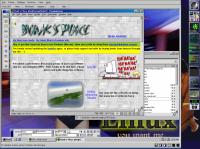 In other news, I’m playing with VMWare under Linux, because I’m addicted to Dreamweaver and will not leave it behind to code HTML by hand. So, here’s a shot of my desktop in Linux with Windows running under VMWare. Freaky, eh? If you don’t like my big-ass 1152×864 desktop, here’s a scaled version (800×600), which is mostly legible.
In other news, I’m playing with VMWare under Linux, because I’m addicted to Dreamweaver and will not leave it behind to code HTML by hand. So, here’s a shot of my desktop in Linux with Windows running under VMWare. Freaky, eh? If you don’t like my big-ass 1152×864 desktop, here’s a scaled version (800×600), which is mostly legible.
I’ve also been using VNC to talk to the Windows machine in the other room and vice-versa. That’s not nearly as elegant, but it’s still pretty nifty. Not sure if I’ll blow the hundred bucks on VMWare once my trial month is up. I’ll keep you updated, k?

Here’s my account of Linux-only for a four-day weekend. Still not perfect, but it seems to be good enough for most folks right now. We’ll see what the next year brings, eh?
Thursday, 1999.12.30
2215 – Leave Windows for Linux Weekend.
2225 – KDE has 384kb of swap used, and I just booted into it. Maybe KDE is a memory hog, as the Gnome fans claim.
2240 – Netscape locks up KDE. Using CTRL-ALT-Backspace, reset X and keep playing.
2245 – Set up a cron job to wake up with. CRON has a very cryptic and non-intuitive format. All dates and times are reverse order. Minutes, then hours? huh?
Friday, 1999.12.31
0900 – Wake to Rave Un2 the Joy Fantastic. Wondering whether mpg123 can play a full playlist, so I check out mpg123 --help and find the answer. Sweeet!
0905 – KDE using 20,712 kb of swap. Seti@Home is a big memory hog, but is running “nice” so not noticeable.
1000 – Surfing with Netscape, listening to KDGE via Real Player G2.
1130 – Inexplicably, KFM now locks up when I try to view my home directory. Whether I look at it via root account or my own, it stops functioning. Waited 30 minutes to see if it would ever move again. No luck. Kill KFM via Ktop, then restart it. Processor usage drops to 3% Probably just make a new user and be done with it…
1430 – After creating a new user, TARring the old info, trying to rebuild the new user, discovered the real reason behind the lockup. Not really a reasonable reason, but what can I do? It seems that one of the Symlinks I had in my home directory pointed to a directory on my FAT32 partition, and kfm wouldn’t show that dir. Oddly, I can go to that directory via any terminal, and there seems to be nothing amiss with it. I can even grab files from it via other programs. The Kpanel application allows me to surf through that directory and grab files, or even open some of the subdirectories within it. AND, I have another symlink to an MP3 directory on that same FAT partition, and it works fine. There is apparently something about the file path /d/Graphics/Stills and /d/Graphics/Stills/Cartoons that KFM doesn’t appreciate. Very Very odd.
1700 – Got mail bounced from AOL. Some cryptic message about DNS failure. Well, I knew it wasn’t MY DNS failure, so it must be that AOL doesn’t like my sendmail configuration. Oddly, I’ve sent mail to AOL users before, without a problem. Soooo, away I go to figure things out in the Sendmail help file. I just set up a rule that sends all mail destined for AOL through my ISP’s SMTP server first. Problem solved. Only took 30 minutes of searching to figure that out. In defense of the Linux email system, I could just have ALL my email sent through my ISP, but then why run Unix, if I have to depend on someone else to do everything for me? hehe
1730 – While attempting to open a Word file, I noticed that it wasn’t associated with any MIME type (equivalent to a file association in Windows). When you try to open an “unknown” file type in X, nothing happens. Here’s something they could definitely swipe from Windows: if I try to open an unknown file in Windows, the system prompts me for which program to run it with, and then asks whether I want to ALWAYS run it with that program. You have to manually add a MIME type or extend an existing MIME type to do the same thing in X. Not for the newbie. And, why didn’t Star Office or WordPerfect (I’ve got both on my system) make that association? They certainly know that MS Word does not exist on Unix. 🙂
1905 – Netscape randomly disappears, while attempting to follow a simple link. Clicked on a normal hyperlink online, and suddenly I’ve got no Netscape window. Check Ktop for status of Netscape; no trace running at present. Wonder why Linux geeks all say Netscape sucks…
2020 – KDE now using 20,204 kb of swap space. Netscape locked up again, so I “Xkill”ed it.
Saturday, 2000.01.01
0015 – KDE has 21,680kb swap used, and 12Megs are from Seti@Home. Everything else is looking good. Setting up a cron job to wake me in the morning. CRONs are still too cryptic.
0920 – Wake to Slick Rick. KDE’s swap usage at 17,452kb, still because of Seti@Home.
0930 – Tired of the same look I’ve had in KDE for a month, I change the theme. Now, my tray icons have disappeared, so I reset X (takes 8 seconds). All better. Resetting X doesn’t kill the Seti@Home task, since CRON set that up automatically every hour in the background.
0950 – Poorly behaved Arkiver program seems to be the culprit in completely locking up the system. Waited 5 minutes, tried CTRL-ALT-BS and CTRL-ALT-DEL to no avail. Hit the power switch. *sigh*
1000 – Rose Parade. 🙂
1530 – Went to AudiUsa site, following link from Slashdot. It immediately told me that I should download Flash or I’d not get the most from the site. Oddly, I have Flash installed. Another site that checks your OS, not your browser capability. “Not Windows or Mac: must need Flash” Send a quick email to webmaster, mentioning that Macromedia’s site seems able to tell that I have Flash installed, why can’t his?
1545 – Swing by Slate to see what’s new in The Papers. Notice there are some interesting commentaries available only if you use Windows Media Player. Fire off a POLITE email to webmaster to ponder the thought of a Real link too. Make it lower quality, so you can still bow to your Microsoft bosses, but at least have an option!
1930 – Found a GUI frontend for Seti@Home. Very sweet, and includes much more info than the “official” Windows client. The Windows client shows the progress via cool looking graphs, but not a view of the SKY. DUH?
2200 – Netscape commits suicide again.
2210 – Annoyed by the Windows Character Set artifacts in the Xlibris web site, email the webmaster to discuss what a standard is and why they are useful. The Smart Quotes feature in MS products does not reproduce well on non-Windows platforms. Nice question marks, eh?
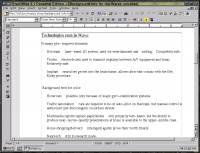 2240 – Loaded up StarOffice. Takes a few seconds to load, and (according to Ktop) uses 15+ megs of Resident memory, with a total footprint of 42megs. Ouch!
2240 – Loaded up StarOffice. Takes a few seconds to load, and (according to Ktop) uses 15+ megs of Resident memory, with a total footprint of 42megs. Ouch!
2350 – Off to bed, with yet another Cron set up for an alarm. Nope, sure can’t just let the same one run every day. Why would I want the same song every morning? hehe
Sunday, 2000.01.02
0945 – Since I was already up and playing tunes, the CRON job that I had set for my alarm generated an error to my email. Nice error-handling. No crash, just a message.
0950 – Netscape stops rendering pages correctly. When I close it normally via the “X” widget, it still hangs out in memory. I checked in Ktop, cuz I was curious. So, I explicitly killed it in Ktop. When is Opera bringing out their Linux browser?
1030 – Netscape suicides again. Gotta give it one thing: most of the time when it commits seppuku, it cleans up after itself.
1200 – Playing with other windowmanagers. Don’t like AfterStep; seems like too much work just to get it to do what I want. Never been fond of Gnome; it’s a big pig and slower than KDE. Since the whole “start menu” thing is not something I’m wedded to, I’m playing with WindowMaker now. I think I can get used to this very quickly. We’ll see what I think about it next week. 🙂
![]() 1920 – Here’s an unusual thing to note. Seems that most Linux geeks must not like to read their email in X, since there are so few X email programs. I personally never liked the MAIL program when I had to use Xenix years ago, and I have gotten very used to a reasonably useful GUI. So, I had to find a decent X email program that would work outside KDE, which has a very nice email program. Found one called TkRat that looks decent. Loving the WindowMaker dock system. Check out what I’ve done in just a few hours!
1920 – Here’s an unusual thing to note. Seems that most Linux geeks must not like to read their email in X, since there are so few X email programs. I personally never liked the MAIL program when I had to use Xenix years ago, and I have gotten very used to a reasonably useful GUI. So, I had to find a decent X email program that would work outside KDE, which has a very nice email program. Found one called TkRat that looks decent. Loving the WindowMaker dock system. Check out what I’ve done in just a few hours!
2010 – Reboot into Windows to play a game. *sigh* Need more Linux games.
2345 – Back in Linux for a while now, and Netscape kills itself again. Very frustrating when you’re attempting to find something online…
Monday, 2000.01.03
1200 – Noticed as I was making this latest entry (via GnotePad, rather than StarOffice) that when I last opened this for editing (Netscape Communicator), the editor stripped out all the ending paragraph tags. Very odd. So, I’ve got a bunch of P tags, but not the /P tags. Whatever.
I’ve decided that I really like WindowMaker. Not much like Windows or CDE, the previous two environments I’d become familiar with, but very very flexible, which I like. I’ve added a cool pseudo-transparent terminal emulator, just for kicks. Kinda pointless, but if you’re going to use Linux you might as well look cool doing it. 🙂
I’ve spent the morning tweaking things for no apparent reason, just so I could have my system exactly the way I want it. Adding things to a new menu item is easy, as is plugging in new dock applets. Well, easy if you know how to use a command line. So, not so easy for newbies. But, newbies probably should stick with one of the mainstream shells, like KDE or Gnome. Fortunately, most of the Gnome apps work in WindowMaker. The KDE apps tend to load KFM when they run, so I’ve been avoiding them until they learn to play well with others. Got a new email program called Postilion. Silly name, but useful program. Even lets me use the mailboxes from Kmail, so I can switch back and forth if I want. Time to investigate filters soon, though. I don’t want to use procmail, but I may have to.
Summary: While I can do most of the things I normally do in Linux, there are still some significant lapses. Most people I know use their computers to check email, surf the web, and (the advanced users) balance their checkbooks. All of those things are available and faster in Linux. The problem I see is that most people get a machine with Windows pre-installed and never add to it. If they got a machine with Linux pre-installed, they’d do the same thing.
I’ve added another page with more screenshots and such, if you’re interested in that stuff. Just follow the link…

Well, I’m going to break with my trend of complete incoherence and go for a set of Software Reviews today… I’ve recently had to do some reconstructive surgery on my computer, so I have new toys. I also did some experimenting, as long as I had to start over anyhow.
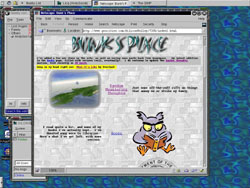 So, although I’ve been very happy with Linux Mandrake for the past year or so, I thought I’d check out Caldera Open Linux, since they had a new version and I’d heard how simple it was to install. Changing into my "newbie" mode, I let it run the install as if I had no clue at all what Linux was. (Well, I did partition the HD, but if you bought the commercial version, it would do that for you too) WOW! It auto-ran from Windows, rebooted itself in DOS-Single mode, ran Loadlin, and started up a stripped-down version of X to install from. No more command line installations for newbies, no sir! OK, a GUI install is pretty, but how is the system? It gives you very few choices when you install the OS, kinda like Windows and unlike most Linux distributions. For most people, that’s good, since they will get less confused by the routine. In about 20 minutes (less than the Windows install I did the same week), I had Caldera Open Linux 2.3 installed and operational. It even recognized my wheel mouse and brand-new TNT2 video card. VERY nice install, and the system is set up for KDE as the desktop, which is good for most folks. Although many reviewers refer to KDE as Windows-like, I think of it more as CDE-like, but I’m familiar with Solaris, and most computer magazine writers apparently AREN’T.
So, although I’ve been very happy with Linux Mandrake for the past year or so, I thought I’d check out Caldera Open Linux, since they had a new version and I’d heard how simple it was to install. Changing into my "newbie" mode, I let it run the install as if I had no clue at all what Linux was. (Well, I did partition the HD, but if you bought the commercial version, it would do that for you too) WOW! It auto-ran from Windows, rebooted itself in DOS-Single mode, ran Loadlin, and started up a stripped-down version of X to install from. No more command line installations for newbies, no sir! OK, a GUI install is pretty, but how is the system? It gives you very few choices when you install the OS, kinda like Windows and unlike most Linux distributions. For most people, that’s good, since they will get less confused by the routine. In about 20 minutes (less than the Windows install I did the same week), I had Caldera Open Linux 2.3 installed and operational. It even recognized my wheel mouse and brand-new TNT2 video card. VERY nice install, and the system is set up for KDE as the desktop, which is good for most folks. Although many reviewers refer to KDE as Windows-like, I think of it more as CDE-like, but I’m familiar with Solaris, and most computer magazine writers apparently AREN’T.
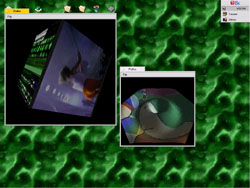 Another fun little doodad I installed recently was BeOS. The Be Operating System was originally designed to out-Mac the Macintosh, and was built for the PowerPC chips. Now, they have had a version out for Intel-compatible chips for a while. I ran its install and poked around a bit. Like Caldera, the Be install is also Windows-aware, and it auto-ran from the CD in
Another fun little doodad I installed recently was BeOS. The Be Operating System was originally designed to out-Mac the Macintosh, and was built for the PowerPC chips. Now, they have had a version out for Intel-compatible chips for a while. I ran its install and poked around a bit. Like Caldera, the Be install is also Windows-aware, and it auto-ran from the CD in 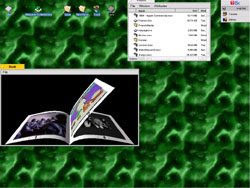 Windows, starting a DOS-mode install and setting up its environment. When it rebooted, it ran Partition Magic Special Edition, created its partition from freespace on the HD, rebooted into the Be install, and installed itself with nearly no interaction from me. In fact, there is almost nothing to decide on during the install, other than which partition to set up on. After it installed, I ran some of the demos, and tried to get online. *BUZZ* Can’t do it. Although Be’s web site claims that my ethernet card is supported, it did not recognize it, even after repeated attempts to make it go. So, it’s off my hard drive again. Maybe next year. The pictures I’ve posted show some of Be’s out-of-the-box demos. The images are NOT stills, they are animated and lighted in real-time, while showing multiple video images and real-time deformation. If you’re a graphics geek, you just said, "cool!" and the rest of you said, "huh?"
Windows, starting a DOS-mode install and setting up its environment. When it rebooted, it ran Partition Magic Special Edition, created its partition from freespace on the HD, rebooted into the Be install, and installed itself with nearly no interaction from me. In fact, there is almost nothing to decide on during the install, other than which partition to set up on. After it installed, I ran some of the demos, and tried to get online. *BUZZ* Can’t do it. Although Be’s web site claims that my ethernet card is supported, it did not recognize it, even after repeated attempts to make it go. So, it’s off my hard drive again. Maybe next year. The pictures I’ve posted show some of Be’s out-of-the-box demos. The images are NOT stills, they are animated and lighted in real-time, while showing multiple video images and real-time deformation. If you’re a graphics geek, you just said, "cool!" and the rest of you said, "huh?"
Some thoughts in comparison between Windows, Linux, and Be:
| Operating System | Installation time | Boot time | Gotchas/summary |
| Windows 98 SE | 3 hours, including futzing around to make it recognize all of my peripherals simultaneously. | 115 seconds (with my Startup group disabled) | Supported by most software makers, but crashes WAY too much. I have to watch my resources like a hawk or the darned thing locks up on me. UDMA is supposed to work, but hangs my system 10% of the time, and it takes forever to startup and shutdown. |
| Caldera Open Linux 2.3 | 35 minutes, including the time waiting for Windows to reboot. | 63 seconds, to a usable GUI desktop after logging in. | Not too much software available off-the-shelf, but plenty available online and in book stores, etc. Great for heavy use, but not really a good game platform yet (except for Loki games). No decent Access-equivalent, but the rest of Office functions are available from StarDivision. |
| Linux Mandrake 6.1 | 40 minutes, mainly because I chose to select individual packages | 73 seconds (more daemons loaded than I need) | Same as Caldera, but Mandrake is better supported by "the community" since it has the same directory structure as Redhat, and Caldera is a little different. |
| BeOS 4.5 | 21 minutes, including Windows rebooting and re-partitioning the HD. | 19 seconds (WOW!) | Quite nearly no software support, with the exception of Macromedia’s promised support. Amazingly fast and flexible system, and based on Unix, so pretty darned secure and stable. |
So, the final verdict is pretty ambivalent. All the OS’s have pluses and minuses, depending on what you want to do with them. Personally, I’m running a dual-boot system. I nuked Be, moved back to Mandrake instead of OpenLinux, and I spend most of my time in Windows. I’d like to spend more time in Linux, but the Gimp is not as friendly to me as Photoshop, I don’t know of a decent HTML WYSIWYG editor, and game support is kinda paltry. But, as soon as I can, I’ll jump to a stable OS, whoever makes it.

Wednesday
So, I’ve got my Linux/Winblows dual-boot box up. I’ve been playing in Linux, using the Mandrake distribution, and surfing along. Then, what should happen but the local cable company tells me they’ll be glad to allow me to be a beta-tester of their new service. Of course, this would be a no-cost setup, with 128kbps access for at least one month before they’ll charge me for it. What geek would say no? Not I, that’s for certain.
So, I headed down and picked up my bag of goodies. Remarkably, compared to horror stories I’ve heard about cable and DSL service, they set me up good. I got a relatively well-written instruction packet, which was only a little inaccurate. They gave me a 6-foot cable and a splitter for the wall, as well as a length of Cat-5 cable to connect to the ethernet card (which I hadn’t bought yet). Of course, being a true geek, I knew that a splitter would introduce too much noise, so I just got my 20-foot cable out of my closet-o-junk and hooked up my magic black box (it really is black polycarb). Now, living in the middle of nowhere as I’m forced to by the government, I had all of 3 stores to try for a network card. Since I actually work during the day, some places are closed by the time a normal person can get to them (gotta love the South). So, to the one place I knew was open late did I go, intending to buy an Intel EtherExpress card, since it is well-supported in all OS’s and is also thought to be a good card. At the local store, I find exactly one PCI ethernet card. Again, as a true geek, I will accept no ISA cards, in case I need more bandwidth someday. The card, when I peered through the dirty glass case, was in the familiar blue-and-white box I’ve come to associate with Intel Ethernet cards, and so I plunked down my 40 bucks and left a happy camper.
Here’s where it goes awry. The card was not, actually, an Intel card, but some Taiwanese knockoff named Addtron. Surprisingly, the driver disk did include Linux drivers, although it was a peculiar exercise getting them installed. So, now I had my super-fast connection in both Windows and Linux. All is right with the world, one would think. Naturally, I can’t leave my system alone for more than a few days. After hooking up my second printer, I had run out of IRQs. And, for some reason, my 6-year-old sound card was acting very oddly, and causing random machine lockups. Since the company was bankrupt, I was unable to get further assistance or new drivers from them. So, off to the store to buy a Soundblaster Live card. Being on night shift this month, I got it set up and then left my machine in Windows, since most of my programs are still in that monstrosity.
I’m on vacation now, and felt the overwhelming need to destroy my machine with more crap. So, noticing that Mandrake has a new CD, version 6, out, I had to try it. Version 6 includes Linux kernel 2.2.9, instead of the 2.0.36 in the older version I had been using. The 2.2.x kernels are supposed to be better, faster, and all that rot. So, away I go, booting into Linux for the first time in a few weeks, and trying to set up my new OS. Since nothing important had been left on Linux, I simply wiped it and started over, and then the trouble began.
My network card, which included Linux drivers, included them only for 2.0.x kernels, and they oh-so-thoughtfully rejected my plea for the source code so I could rebuild them. For some reason known only to their upper management, they have a policy against releasing the source code for their drivers. This makes absolutely no sense to me, since you must actually purchase one of their cards for the driver to be of any use anyway. So, what would it possibly harm to let me see the source?
Next, I decided to set up my SBLive. Here’s another pickle. The SBLive includes, on their website, the drivers needed for Linux. But (you knew there’d be one, eh?), the drivers are (naturally) only in binary, and will only install on 2.0.36 or 2.2.5, which is at least a month old. In Linux-land, compiling for one specific patch level is absurd, but there you have it. No response at all from Creative Labs, which isn’t surprising since they don’t actually have an email address listed on their website. Now, how the hell is that a good idea? Faxes are better than email to a technology company?
*SIGH* So, now I’m off to re-install Linux Mandrake 5.3, with the 2.0.36 kernel. But, yaknow, if I could get the network card to work, I’m not gonna sweat the soundcard too much. Mandrake 6 includes a great Windowmanager built into the bootup, too. Oh, well, it’s not easy being on the bleeding edge of technology.
Last Edit: 05 Jun 2004 @ 07:44 AM
Email • Permalink • Comments Off on Linux and Cable modems

Saturday
Continuing my adventures with Linux…
Well, I went ahead and bought a new video card to fix the video problems in Linux. Since I hadn’t actually installed anything special in Linux, I wiped it and started over. I added another 6.4 gig hard drive to my Frankenstein machine while I was at it.
So, I installed the 16meg Riva TNT card (only 78 bucks!), the new HD, partitioned, copied, etc. This time, when I popped in the Linux CD, everything went smoothly. Knowing I had to reboot a couple times to get the sound to work helped my headaches stay minimized. Now, after about a week or so running this dual-boot configuration, I’ve installed StarOffice for Linux, and set up a few other things. I’m reading Running Linux and attempting to muddle through. My experience with Unix in Korea helps, but only a little. 🙂
I have about 3 gigs devoted to Linux now, and I’ve got Bootmagic set up to dual boot into either Linux or Win98. While I was updating things, I set up IE 5.0 on the Win98 side, and I can’t tell much difference from IE 4, except I can actually read stuff in the status bar again. They made it back to a normal size, instead of giving 3/4 of the space on the status bar to "Internet Zone" information.
Now, I plan to recompile the kernel, play with Afterstep instead of KDE for a while, and otherwise see if I can completely destroy the little free time that I have.
TTYL.

Thursday
Although I have tried Linux before, it seems to be the month of the Open Source, so I gave it another try recently. WOW! What a difference a year makes. The installation I tried was a CD I burned myself (love those toys) of Linux-Mandrake. Mandrake is really nothing more than Red Hat 5.2 with the K Desktop Environment thrown into the install program.
So, here’s my experience and impressions so far. I downloaded the full ISO image of the CD (45 hours, don’t try this without some industrial strength download-resumption software). Then, after I burned it onto a blank CDR, I ran Partition Magic to clear up some extra partitions. I created a Linux Ext2 partition (500 megs) and a Linux Swap partition (80 megs). Prepared, with all my most important data files backed up to a CDRW disk (toys, toys, toys!), I plunged into the install routine with hope and more than a bit of dread. About 10 months ago, I tried something very similar with Debian (an older version to be fair) and ended up spending much time rebuilding my trashed partition tables and FATs. This time, though, was very different.
After the CD booted (love those bootable CD’s), it started the Linux-Mandrake-Redhat install routine. I stepped through the easy-to-follow (for a geek) setup and had myself a working Linux box in no time, with a dual-boot configuration to Win98 (scourge of evil but a necessary evil), and even had KDE running in a crappy 256-color mode. My modem wasn’t recognized, and my printer would not print. My sound card made one squawk and stopped. ARGH! After many trips to the HOWTO files from the CD, I got everything working, with the exception of my video. I can SEE everything, but I can’t convince the X server that my video is capable of more than 8-bit color (currently using 16-bit in Win98, with on-the-fly to 24-bit). And, more maddening, the video gives me little drop-out lines. Totally undocumented by any other victim/user of Linux that I’ve been able to find with WebFerret, Slashdot, UGeek, or 32bitsOnline. But, I have an old crappy video card, and that Riva TNT looks awfully nice, especially at $89…

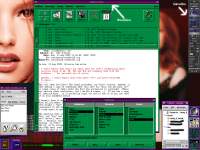
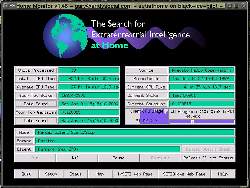
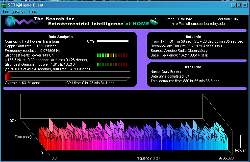
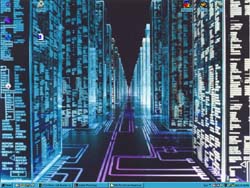




 Categories
Categories Tag Cloud
Tag Cloud Blog RSS
Blog RSS Comments RSS
Comments RSS
 Last 50 Posts
Last 50 Posts Back
Back Void
Void  Life
Life  Earth
Earth  Wind
Wind  Water
Water  Fire
Fire